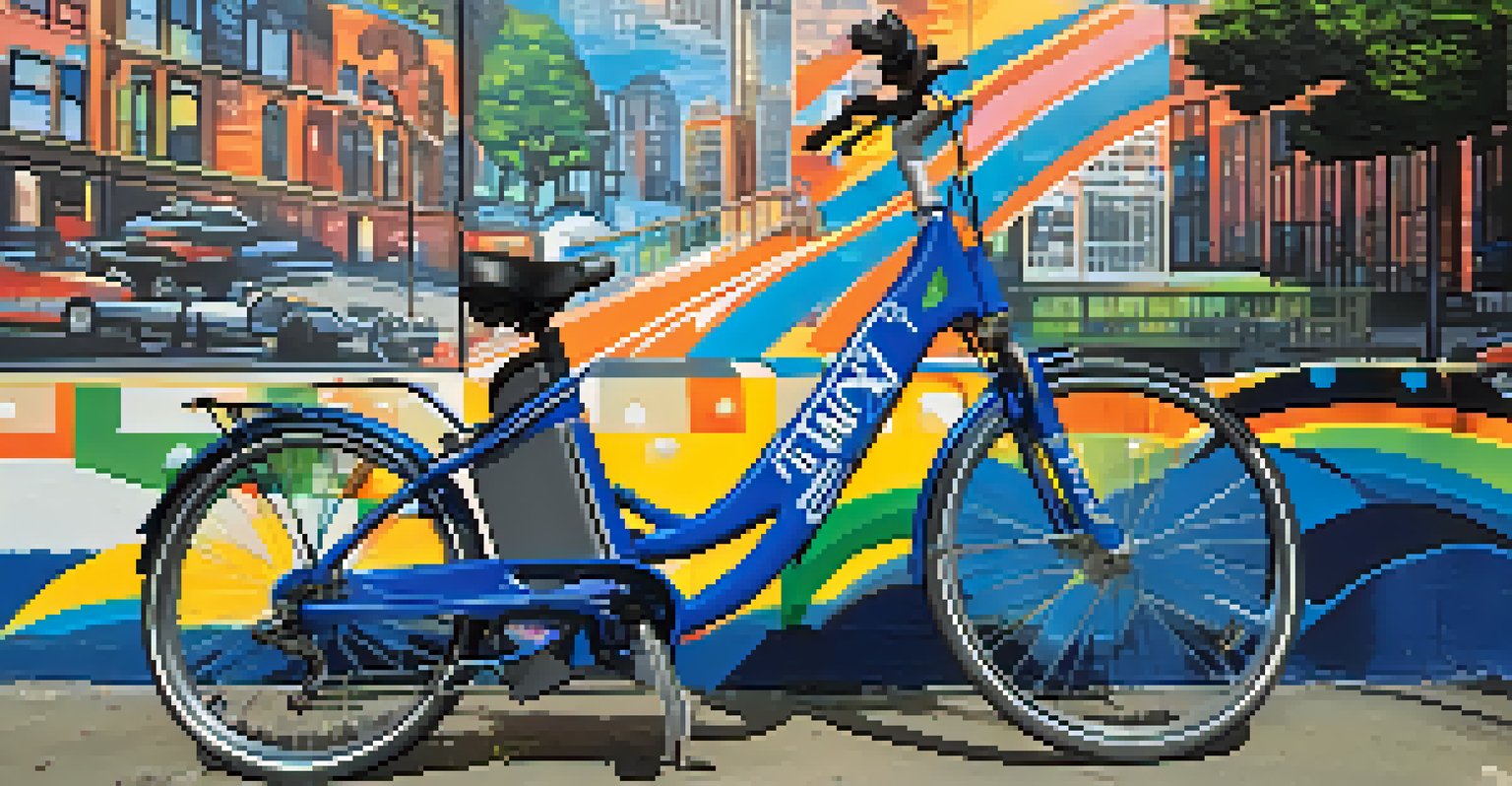Bike-Sharing Programs: Enhancing Urban Mobility in NYC

Understanding Bike-Sharing Programs in NYC
Bike-sharing programs have gained immense popularity in urban areas, including New York City. They provide residents and visitors with an accessible and eco-friendly mode of transportation. Essentially, these programs allow users to rent bicycles for short periods, making it convenient to navigate the bustling city streets.
Bicycling is a big part of the future of urban mobility. It's an efficient and environmentally friendly way to get around cities.
In NYC, the most notable bike-sharing program is Citi Bike, which launched in 2013. With thousands of bikes and docking stations scattered across Manhattan, Brooklyn, and beyond, it’s easy to find a bike when you need one. The program has revolutionized how people think about commuting, offering a flexible alternative to traditional public transport.
The success of bike-sharing in NYC is evident, with millions of rides taken each year. This trend reflects a growing awareness of the benefits of cycling, such as reduced traffic congestion and lower carbon emissions. As more people opt for bikes, the city becomes increasingly navigable and enjoyable for everyone.
Benefits of Bike-Sharing Programs for Urban Mobility
Bike-sharing programs enhance urban mobility by providing a quick and efficient transportation option. They fill in the gaps where public transport may fall short, especially for short trips. Imagine needing to travel just a few blocks—getting on a bike is often faster than waiting for a bus or subway.

Additionally, these programs promote healthy lifestyles. Cycling is a great way to incorporate exercise into daily routines, helping to combat sedentary habits. With bike-sharing, it’s easy to hop on a bike, get some fresh air, and enjoy the city while staying active.
Citi Bike Revolutionizes Commuting
Citi Bike has transformed urban transportation in NYC by providing a flexible and eco-friendly option for residents and visitors.
Moreover, bike-sharing contributes to reduced environmental impact. Fewer cars on the road lead to decreased air pollution and lower greenhouse gas emissions. By choosing to cycle instead of drive, individuals can play a part in creating a more sustainable urban environment.
Challenges Faced by Bike-Sharing Programs
While bike-sharing programs offer numerous benefits, they also face several challenges. One significant issue is the need for safe cycling infrastructure. In many areas of NYC, cyclists must navigate busy streets without dedicated bike lanes, which can be intimidating for new riders.
We need to make cycling safer and more accessible to everyone, not just the strong and brave.
Moreover, maintenance and bike availability can be problematic. During peak times, bikes may not be readily available at certain docking stations, leading to frustration for users. Ensuring that bikes are properly maintained and accessible is crucial for the program's success.
Lastly, there’s the challenge of integration with other forms of transportation. To maximize efficiency, bike-sharing must work in harmony with subways, buses, and other transit options. This requires ongoing collaboration between different transportation agencies and the bike-sharing program.
The Role of Technology in Bike-Sharing Programs
Technology plays a pivotal role in the operation of bike-sharing programs. Users can easily locate bikes and docking stations through mobile apps, making the experience seamless. These apps often provide real-time information on bike availability, which is essential for planning trips.
Furthermore, smart-lock technology has enhanced the security of bike-sharing systems. With features like GPS tracking, stolen bikes can be located quickly, helping to deter theft. This technological advancement not only protects the bikes but also boosts user confidence in the program.
Health and Environment Benefits
Bike-sharing programs promote healthier lifestyles and reduce environmental impact by encouraging cycling over driving.
Additionally, data analytics helps program operators understand usage patterns. By analyzing when and where bikes are used, cities can make informed decisions about expanding or adjusting the bike-sharing network. This data-driven approach ensures that the program continues to meet the needs of the community.
Citi Bike: A Case Study of Success
Citi Bike’s journey serves as a prime example of how effective a bike-sharing program can be. Since its inception, it has expanded significantly, now boasting over 1,000 docking stations and thousands of bikes. This growth reflects the increasing demand for alternative transportation options in the city.
The program has also implemented various initiatives to enhance accessibility. For instance, discounted memberships are available for low-income residents, ensuring that everyone can benefit from this service. This inclusivity is vital for creating a truly diverse cycling community.
Citi Bike’s success has inspired other cities to adopt similar programs. As urban centers worldwide look for solutions to transportation challenges, they often turn to bike-sharing as a viable option. This trend highlights the program's potential to influence urban mobility on a global scale.
The Future of Bike-Sharing in NYC
Looking ahead, the future of bike-sharing in NYC is promising. With ongoing investments in cycling infrastructure, the city is committed to supporting and expanding its bike-sharing programs. As more bike lanes are added, cycling will become a safer and more appealing option for residents.
Moreover, the rise of electric bikes (e-bikes) is set to change the landscape of bike-sharing. E-bikes allow riders to cover longer distances with less effort, making cycling accessible to a broader audience. Integrating e-bikes into programs like Citi Bike can attract even more users.
Challenges and Future Prospects
Despite facing challenges like infrastructure and bike availability, the future of bike-sharing in NYC looks promising with investments and community engagement.
Lastly, community engagement will play a crucial role in the future of bike-sharing. By listening to feedback and addressing concerns, program operators can create a more user-friendly experience. As cities evolve, bike-sharing programs must adapt to meet the needs and preferences of their communities.
Conclusion: Embracing Bike-Sharing for Urban Mobility
In conclusion, bike-sharing programs like Citi Bike are transforming urban mobility in NYC. They offer a practical solution to transportation challenges while promoting sustainability and healthy lifestyles. As more people choose to bike, they contribute to a vibrant, interconnected city.
While challenges remain, advancements in technology and infrastructure improvements will continue to enhance these programs. The commitment to creating a bike-friendly environment signifies a progressive step toward modern urban planning. It's an exciting time for cycling enthusiasts and casual riders alike.

Ultimately, embracing bike-sharing is about more than just getting from point A to point B. It's about fostering a sense of community, encouraging active living, and paving the way for a greener future. With continued support and innovation, bike-sharing programs can play a pivotal role in the urban landscape of NYC.